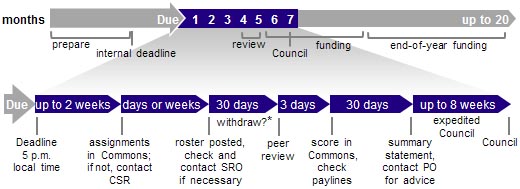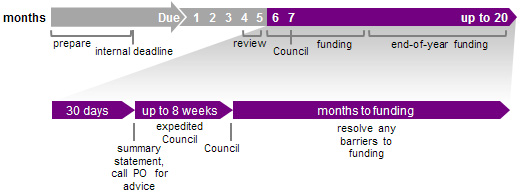Timelines for Assignment, Review, & Funding
Here you'll find your timing-related actions for requesting assignment to an institute and study section and for initial peer review.
Know what materials you may be able to send to your scientific review officer after submission.
Several important events take place around this time. Before the review meeting, NIH posts study section rosters; after the meeting, it posts scores and summary statements in the eRA Commons.
Know your actions and when to take them, and learn about the timing of awards—after the advisory Council meeting or earlier for some applications.
Timeline for Assignment and Review

The upper timeline shows major steps from application to award for a simple non-AIDS application, such as an R01, as described in full at Timeline for Planning a Grant.
Expanding the colored section in the top timeline, the lower timeline shows major action items and timeframes for this stage in more detail:
- After the NIH deadline, you should see your assignments in the Commons within two weeks. If not, contact NIH’s Center for Scientific Review.
- 30 days before the peer review, you should see the review roster posted in the Commons. Check it and contact the scientific review officer (SRO) if necessary.
- You can withdraw your application until the review meeting without its counting toward your one resubmission limit.
- Your application undergoes initial peer review.
- Within three days after the review, you should see your score in the Commons. Check paylines.
- Within 30 days after the review, you should see your summary statement in the Commons. Contact your program officer for advice on your funding chances.
- Council is up to 8 weeks later, but some applications that scored well undergo expedited Council meanwhile instead.
Read more at:
- Application Assigned to a Review Group,
- First-Level Peer Review, and
- Second-Level Review: Advisory Council.
Timeline for Funding Decisions

The upper timeline shows major steps from application to award for a simple non-AIDS application, such as an R01, as described in full at Timeline for Planning a Grant.
Expanding the colored section in the top timeline, the lower timeline shows major action items and timeframes for this stage in more detail:
- During this time period, resolve any barriers to funding such as bars to award.
- If your application is expedited, you could be funded as early as six months after the due date.
- After Council, we continue funding based on paylines and in score order.
- Some must wait until near the end of the fiscal year to get a grant, which may be as long as 20 months after your original due date.
- Before funding, you must resolve any barriers to funding, including sending just-in-time information. Read more in Responding to Pre-Award Requests ("Just-in-Time").
Read more about NIAID’s Funding Decisions and Your Next Steps or read on for more background on how the fiscal year affects timing.
Funding Is Tied to the Fiscal Year
Only about half of fundable R01 applications typically receive an award within six to eight weeks after our advisory Council meeting, and we fund the largest number in the last half of the fiscal year.
"Promptly" means you see your Notice of Award in the Commons within six to eight weeks of our advisory Council meeting, earlier if your application underwent expedited second-level review.
For an investigator-initiated application, time to award depends to a great degree on which of the three cycles you choose. Read more on the cycles in that section of Understanding Due Dates, Preparation Time, and Review Cycles.
Below we discuss award timing for the different cycles for applications that scored within and above the payline and describe the advantages and disadvantages of each cycle.
Application scores within the payline. If your application scores within the payline, we will fund it, assuming it has no administrative issues, e.g., for research animals or human subjects.
But at the beginning of a fiscal year—which begins on October 1—awards for Cycle 1 applications are usually delayed because we don't have a budget. Typically, Congress has not yet passed our appropriations bill, so we do not know how much money we will have to fund grants.
Here's what happens.
We begin each fiscal year using interim paylines so we can start making some awards.
- An interim payline is an administrative measure. It is not a true payline in that it is not based on our budget.
- Interim paylines enable us to get very low-scoring grants out the door (at NIH, the lower the score, the higher the quality of the application).
After Congress passes our appropriations bill and the president signs it into law, our budget office crunches the numbers and sets our new paylines so we can start awarding more grants.
We generally start posting interim paylines in the fall and post actual paylines in winter or sometimes even spring.
For an illustration of these events, see the table below.
For an above-the-payline application, you have the longest pause for Cycle 1— possibly an additional 10 months—for a funding decision.
Application scores above the payline. If your application scores above the payline—even just above—it may be deferred for a funding decision until near the end of the fiscal year for a different reason than the one described above.
We set our actual paylines at very conservative levels because we don't know the scores of applications coming in later in the fiscal year. (Note that here we are referring to our actual, not interim, paylines.)
As a result, toward the end of the fiscal year we stop using paylines and make more—often many more—awards.
We fund many of those applications by percentile or overall impact/priority score order and pay others that are programmatically important. That last point is a good reason for you to discuss the importance of your research with your program officer before applying.
For an above-the-payline application, you also have the longest pause if you applied for Cycle 1. You may need to wait till the next August—possibly an additional 10 months—for a funding decision.
Because other actions are possible, talk to your program officer about your options if funding is not imminent.
Correlation of Budget, Fiscal Year Stage, and R01 Payline With Hypothetical Timing
| October to January | Winter Until Spring | Several Weeks Later | August to September |
|---|---|---|---|
|
No budget yet October 1—fiscal year begins. Usually, we do not have a budget and operate under a continuing resolution at the previous fiscal year's funding level. We use interim paylines to fund a limited number of applications. Other awards are delayed. |
Have a budget Congress passes our appropriations bill, and the president signs it into law, setting NIH's budget levels. For the next several weeks, budget figures are analyzed and parsed within the Department of Health and Human Services before the new budget figures arrive at NIAID. |
Crunch budget numbers Over several weeks, our budget office sets a conservative R01 payline that we maintain until the end of the fiscal year approaches. We fund Council-approved grant applications that rank within the payline and a few others through special funding programs. |
Close of the fiscal year begins. Around this time, we stop funding by paylines because they are no longer relevant. Because we set our paylines conservatively, we usually have money left over at the end of the fiscal year to fund some of the deferred applications that missed the payline. |
Find more details at NIAID’s Paylines and Budget Information Changes Throughout the Year.
Have Questions?
A program officer in your area of science can give you application advice, NIAID's perspective on your research, and confirmation that NIAID will accept your application.
Find contacts and instructions at When to Contact a NIAID Program Officer.


